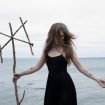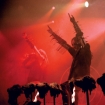Wolves in the Throne Room have been walking their own unique path since the band's inception in 2003. Eschewing the typical black-metal tropes of Satanism, black magic and chaos, the Olympia, Washington-based band instead channels the natural energy of the forest it calls home. Wolves in the Throne Room have gone through several incarnations over the years, with the only consistent members being the Weaver brothers, Aaron and Nathan.
For their sixth full-length album, Thrice Woven (out today on Artemisia Records), the brothers took a monastic approach to the writing process, and sequestered themselves away in a studio tucked in the middle of the woods.
"Me and Nathan locked [ourselves] in our studio together in the winter, with the wood stove going, each of us working 12 hours a day just writing material — either by ourselves or working together — creating a real tight container to make this record," says Aaron.
The experiment paid off, as heard in Thrice Woven's range of thrashing black metal ("Born From the Serpent's Eye"), epic gloom ("The Old Ones Are With Us," which features a haunting invocation and acoustic guitar work from Neurosis' Steve Von Till) and cinematic sonic destruction ("Angrboda" and "Fires Roar in the Palace of the Moon").
Below, Aaron Weaver explains the connection between the Pacific Northwest forests in which he lives, and Wolves in the Throne Rooms' dark musical expression.
HOW MUCH OF AN IMPACT DOES YOUR ENVIRONMENT HAVE ON THE MUSIC OF WOLVES IN THE THRONE ROOM?
AARON WEAVER For me, it's everything. As we go along with this band and get deeper and deeper into it, I realize that there's no separation. Me and Nathan live right on the edge of this beautiful forest of cedar and fir trees that was clear-cut in 1910 or so. It's been growing back wild ever since. This is where our studio is and these are the woods I grew up in. It's a process of watching the woods grow up, too. I remember when I was a kid, 30 years ago, there weren't any ravens in the woods; the trees were smaller. Now 30 years later, the ravens are back, the owls are back, all kinds of different creatures are back in the woods and the trees are big and mature. The music of Wolves in the Throne Room flows from this place. Being in these woods and swimming in the salt water is the inspiration and energy that we turn into music.
IS THERE A PHILOSOPHICAL OR SPIRITUAL ELEMENT THAT CONNECTS YOU TO THE FOREST?
No, there's no philosophy, there's no spirituality. Those words don't really mean a lot to me. It's the experience. It's in the body. What I notice about being in a wild place away from people, is I get more tuned-in to my body, to my somatic experience, to my senses. My sense of smell is stronger. I hear things more. I notice the spider webs and I spot the deer out of the corner of my eye. That's what it is for me. It's not philosophy — it's a different way of tuning in to life.
YOUR PREVIOUS ALBUMS, TWO HUNTERS, BLACK CASCADE AND CELESTIAL LINEAGE, FORMED A TRILOGY. DOES THRICE WOVEN FIT INTO ANY KIND OF CONTINUUM?
No, this album feels fresh to us for so many reasons. We took a breather to record Celestite, which is the ambient album that came out in 2014. We built a recording studio, Owl Lodge, because we knew we wanted to make another black-metal record and we also knew that we wanted to record most of it at home, at Nathan's place, which is our band headquarters. We spent about a year building the studio, hanging the sheet rock and framing, electrical and then some time buying and setting up gear. After that I just took some time to start making music in that space: tune it up, light fires in there, light candles and just be really free with the music and eventually it was time to make another Wolves in the Throne Room record.
NOW THAT YOU HAVE A RECORDING STUDIO, WHAT WAS THE RECORDING PROCESS LIKE? WAS IT ALL TRACKED AT OWL LODGE?
With the drums, it's all about the room. It's all about getting a beautiful-sounding room. So we did the drums at a studio called Litho in Seattle, which was awesome because Litho is owned by Stone Gossard from Pearl Jam and it's just got this amazing Seattle vibe. It's right in Fremont, a really cool neighborhood right on the water. The studio has this massive wrought-iron chandelier, easily 16-feet across. It's got easily 150 candles that go on it. When you light up that chandelier in that space, it's just really magical in there. The drums sound cool in that room.
We did the drums there with Jack Shirley, a Bay Area–based engineer and producer. Once we finished the drums, we brought the sessions back to our studio in Olympia, Randall Dunn showed up and we kind of made a plan on how to put the record together. Building a record like Thrice Woven is like building a house: There's so many pieces, it's complicated. Randall created the architecture, how to put it together, how to make it sound killer.
Me and Nathan would work by ourselves, tracking guitars, synthesizers, whatever then Randall would show up and kind of check it out and give suggestions. He tracked a lot of stuff too — he always plays a little bit of synthesizer on our records. Once all the tracking was wrapped up, we met up with Randall again in Seattle and mixed at Avast! Studio, another really awesome, vibey Seattle studio that's part of the Soundgarden lineage. The guy that owns Avast! was Soundgarden's front-of-house guy back in the early days. It's just a cool place. It's got a really good vibe, really amazing gear and a very good history of music in Seattle. It's one of these temples where amazing records come out of.
YOU AND NATHAN ARE THE PRIMARY ARCHITECTS OF WOLVES IN THE THRONE ROOMS' SOUND, BUT YOU'VE ALWAYS FOUND INTERESTING MUSICIANS TO COLLABORATE WITH ...
There's always been other collaborators. We can go back even farther to Diadem of 12 Stars and Two Hunters — I always want people to remember that Rick Dahlin played guitar on those records. He wrote a third of the riffs. On Black Cascade, our good friend Will Lindsay played guitar and he was a part of that record. Celestial Lineage was the first record that me and Nathan wrote by ourselves. That was my time to step up and play a lot of guitar.
The story of Thrice Woven is now we've got another member again. About halfway through recording, we realized it was time to invite Kody Keyworth to be a full member of the band. He'd been playing guitar on the road with us for six years. As we were recording Thrice Woven, we just realized that Kody's got to be on this record — he's a part of this band from now on.
WILL YOU BE PERFORMING WITH THE BAND ON THE UPCOMING TOURS?
On this tour cycle, Trevor Deschryver is playing drums. He is amazing. He came up to Olympia and stayed here for a few weeks. He can do everything I can do and more. This is the best-sounding lineup we've ever had, especially with Peregrine Somerville playing third guitar and Brittany McConnell from Wolvserpent playing keyboards and also doing some drumming.
THERE'S A VERY PARTICULAR, DETAILED WAY THAT YOU PRESENT THE MUSIC LIVE, EVEN DOWN TO THE TYPE OF VENUE YOU GUYS PLAY IN. CAN YOU COMPARE AND CONTRAST THE LIVE MUSIC EXPERIENCE WITH THE RECORDED ONE?
They're different worlds, for sure. I listen to our records every couple of years, just to check back in with it, see how I feel about it, what comes up for me. I always do that by myself because it's a very inward-looking experience. For me, this music brings me inwards. When I'm in a recording studio or I'm listening to a record, I'm going deep inside myself, looking at places inside myself. The live experience is the other side of that, it's outward, it's all about the community, it's all about the family and the tribe and the audience and the band sharing an experience together. It's a coming together of people.
We like being on a stage because so much of what we're trying to do is visual. If we're on the floor, no one can see what we're doing. We're definitely going to step it up on the next tour. We're having a wonderful artist, a friend of ours, design new banners. For the tour we have coming up, we're going to have a new amazing and beautiful stage performance.











